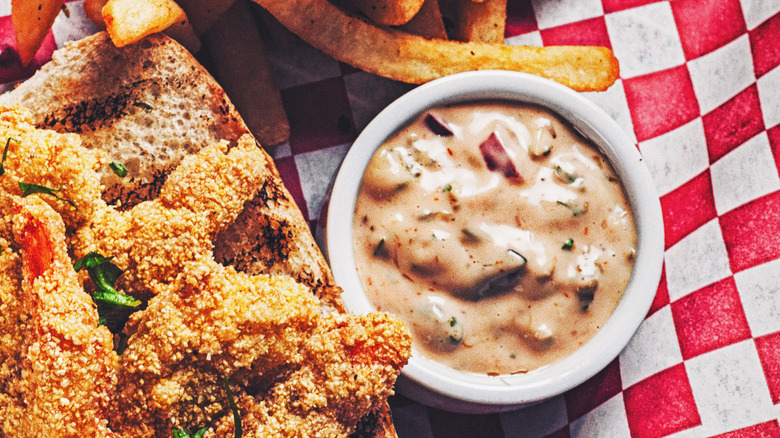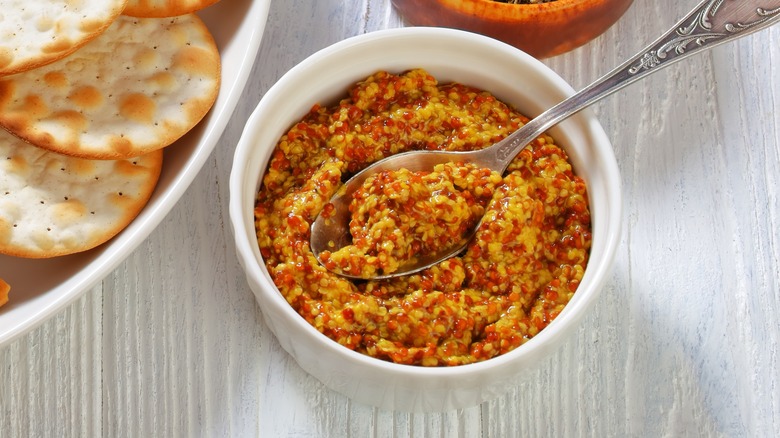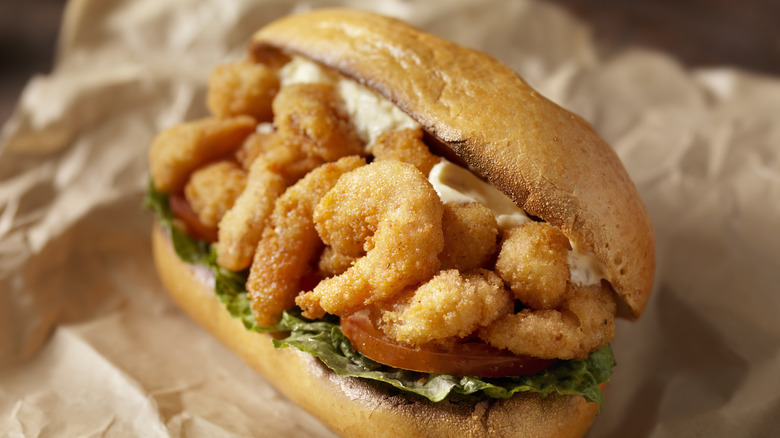Whip Up Some Creole Mayonnaise For A Vibrant Twist On The Classic
Mayonnaise has had an interesting history, from its position as a luxury food in the 19th century to its rise in 2021 to become the most popular condiment in the United States. Its journey has also seen the classic recipe adapt and evolve, and now you'll find countless brands and varieties of mayonnaise available. One addictive and versatile version is Creole mayonnaise. So, what makes Creole mayonnaise so unique? It's deliciously zingy and herby and goes well with almost anything.
At its simplest, it is a mix of mayo, Creole mustard, and Creole seasoning. The combination of these ingredients creates a tangy and exciting concoction that's ideal as a spread, sauce, or dip. The Creole mustard and seasoning also build on the creamy tang of the mayonnaise to add a vibrant depth of flavor.
Creole cuisine typically originates from French culinary traditions, but it was also influenced by the various groups who settled in Louisana; this included Caribbean, Spanish, African, and Italian people, as well as the Native Americans who lived there first. To understand the flavor of this mayonnaise and its representation of the rich cultures of New Orleans, you simply need to unravel the Creole ingredients within.
The essential Creole ingredients
The essential ingredients in Creole mayonnaise not only create a taste that is truly distinctive but also highlight the contributions of various cultures to Creole cuisine. Creole mustard is made with brown mustard seeds and horseradish, which explains why it's typically pretty fiery. It's also usually more acidic than Dijon and includes various herbs and spices, like allspice, nutmeg, cloves, and tarragon, to give it a complexity and a bolder edge. Creole seasoning is also a spicy affair and usually has a mixture of paprika, salt, garlic, onion powder, cayenne, oregano, thyme, basil, and pepper.
These spicy-herbaceous Creole ingredients add a fantastic punch of flavor to the mayonnaise, also giving it that orangey hue and slightly grainy consistency. Both of these Creole ingredients are also wonderful examples of the influences of different cultures on Creole cuisine: Paprika is commonly used in African cooking, while thyme is associated with the Mediterranean region.
The final crucial ingredient is mayonnaise, which, with its heated origin story, has roots in both France and Spain. When combined, this Creole mayonnaise embodies a vibrant flavor that beautifully encapsulates the diverse cultural influences of New Orleans.
What to pair it with
Alongside these core ingredients, different variations on the recipe add extras that pull on other flavor strings. For extra tang, you can use Worcestershire sauce or shallots; for extra acidity, you can add white wine vinegar or lemon juice; and to increase the spiciness, an extra dose of horseradish is often added. You can also incorporate flat-leaf parsley for a burst of freshness. This addition will also introduce a colorful contrast with bright specks of green.
Creole mayonnaise and its remoulade counterpart were traditionally served with hard-boiled eggs as a more affordable option than meat or seafood. However, today, it is commonly paired with fish, seafood, and cold meats. Far beyond these conventional uses, Creole mayonnaise's versatility stretches to being a substitute for butter, a replacement for mayonnaise in a potato salad, and the ultimate condiment on a chicken burger.
Just like ordinary mayonnaise, this Creole twist is addictive in a variety of dishes. The smooth, herby, and spicy flavors are a superb way to level up just about anything savory. Whip up a batch and see where this versatile mayonnaise takes you.


